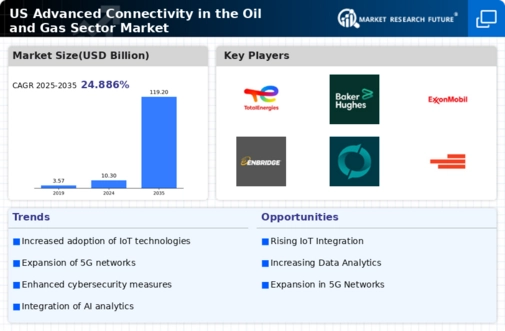Adoption of Smart Technologies
The adoption of smart technologies is reshaping the landscape of the advanced connectivity-in-the-oil-and-gas-sector market. Innovations such as artificial intelligence (AI), machine learning, and the Internet of Things (IoT) are being integrated into operations to enhance connectivity and data management. These technologies enable predictive analytics, which can foresee equipment failures and optimize maintenance schedules. The market for smart technologies in the oil and gas sector is expected to reach $10 billion by 2026, reflecting a growing recognition of their potential to transform operations. As companies strive to remain competitive, the integration of smart technologies will likely drive further advancements in the connectivity landscape.
Increased Demand for Real-Time Data
The advanced connectivity-in-the-oil-and-gas-sector market is experiencing a surge in demand for real-time data analytics. This trend is driven by the need for enhanced operational efficiency and decision-making capabilities. Companies are increasingly adopting advanced connectivity solutions to monitor drilling operations, production levels, and equipment health in real-time. According to recent estimates, the market for real-time data analytics in the oil and gas sector is projected to grow at a CAGR of 15% through 2027. This growth is indicative of the industry's shift towards data-driven strategies, which are essential for optimizing resource allocation and minimizing downtime. As operators seek to leverage data for competitive advantage, the advanced connectivity-in-the-oil-and-gas-sector market is poised for significant expansion.
Investment in Digital Transformation
Investment in digital transformation is a crucial driver for the advanced connectivity-in-the-oil-and-gas-sector market. Companies are increasingly recognizing the importance of digital technologies in enhancing operational capabilities and driving innovation. This shift is evidenced by the substantial investments being made in digital infrastructure, with projections indicating that spending on digital transformation in the oil and gas sector could exceed $30 billion by 2025. Such investments are aimed at modernizing legacy systems and integrating advanced connectivity solutions that facilitate better data sharing and collaboration. As the industry embraces digital transformation, the advanced connectivity-in-the-oil-and-gas-sector market is likely to witness accelerated growth.
Enhancement of Operational Efficiency
Operational efficiency is a paramount concern within the advanced connectivity-in-the-oil-and-gas-sector market. Companies are increasingly investing in connectivity solutions that streamline operations, reduce costs, and enhance productivity. The integration of advanced technologies, such as cloud computing and machine learning, allows for better resource management and predictive maintenance. Reports indicate that organizations implementing these technologies can achieve cost reductions of up to 20% in operational expenditures. This drive towards efficiency is not merely a trend but a necessity for survival in a competitive market. As the industry continues to evolve, the focus on operational efficiency will likely remain a key driver for the advanced connectivity-in-the-oil-and-gas-sector market.
Regulatory Compliance and Safety Standards
Regulatory compliance remains a critical driver for the advanced connectivity-in-the-oil-and-gas-sector market. The industry is subject to stringent regulations aimed at ensuring safety and environmental protection. As regulations evolve, companies are compelled to adopt advanced connectivity solutions that facilitate compliance with safety standards and reporting requirements. For instance, the implementation of real-time monitoring systems can help operators adhere to regulations set forth by agencies such as the Environmental Protection Agency (EPA). The financial implications of non-compliance can be severe, with potential fines reaching millions of dollars. Thus, the need to meet regulatory standards is a significant factor propelling the adoption of advanced connectivity technologies in the oil and gas sector.























Leave a Comment